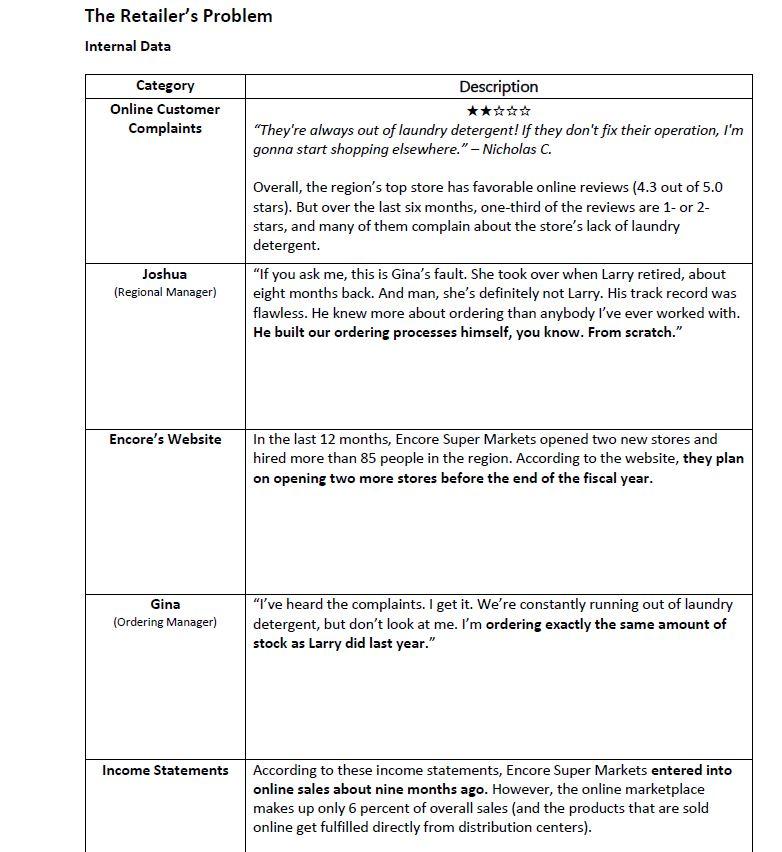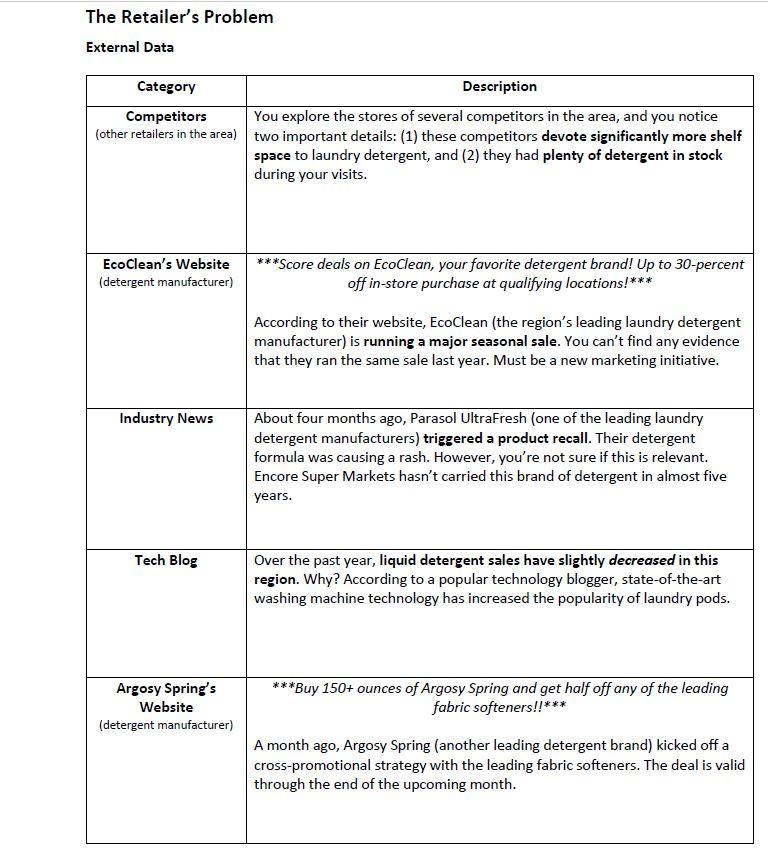Question
THE RETAILER'S PROBLEM Introduction: Encore Super Markets is one of the fastest-growing retail chains in its region. It has six locations in the area, and
THE RETAILER'S PROBLEM
Introduction: Encore Super Markets is one of the fastest-growing retail chains in its region. It has six locations in the area, and every location carries multiple categories for consumer product goods: convenience goods, shopping goods, specialty goods, and more. The retailers growth has been unprecedented, but a few months ago, they encountered a problem.
Their Current Situation: Theyve been consistently running out of laundry detergent in every single one of their regional stores. They dont know whats causing it, but they do understand their failure cost:
Customers are getting upset because their local Encore Super Market is consistently out of laundry detergent
Laundry detergent manufacturers are getting frustrated. Theyre willing to provide Encore with as much product as necessary, so theres really no excuse to not have the product in stock
Their Required Situation: Ideally, theyd have exactly the right amount of laundry detergent in stock. They dont want to run out, but they dont want a huge surplus either.
Your Role: Encore Super Markets corporate office has hired you to solve this problem. Using the data provided on the Foundation tab, explain three things:
Why are they running out of laundry detergent?
How can they fix this problem and prevent it from happening in the future?
How can Encore turn their customer dissatisfaction into customer delight?
Your Goal: Investigate Encore's problem situation, develop probable causes, and verify those causes.
Your Resources: Below, you'll find internal data and external data related to the problem. This data will help you solve this problem.
Internal data is information you can gather from within Encore's business
External data is information you can gather from outside Encore's businessfor example, data from Encore's competitors, industry news, market trends, etc. Dont ignore any data source, but make sure all the data you collect is directly related to the problem you're trying to solve. A lot of data can seem very interesting, and it'll sidetrack you into doing a lot of research that isn't relevant to the problem. You can avoid this problem by using the Is/Is-Not Analysis tool.
Your Tools: As you analyze the problem, don't forget about your investigative tools:
The 5P Framework
Is/Is-Not Analysis
Cause-Effect/Fishbone Diagram
The Human Performance Formula
Question 1: Is this problem familiar or unfamiliar? What are some of the costs of failure for external customers, employees, and the organization?
Question 2: Investigate the Internal and External Data that is available to you (or is provided in this case study). Using the 5P Framework and Is/Is-Not Analysis, list out all the People, Process, Position, Period, and Progression data that IS CONTRIBUTING to the problem.
Question 3: Investigate the Internal and External Data that is available to you (or is provided in this case study). Using the 5P Framework and Is/Is-Not Analysis, list out all People, Process, Position, Period, and Progression data that IS NOT CONTRIBUTING to the problem.
Question 4: Craft a concise problem statement (three sentences or fewer). Include the organizations current problem situation, the required situation, and some of the variables the organization can use to track the severity of the problem (e.g., sales volume, number of defects, etc.). Be absolutely precise with your words. If your problem statement is vague, it may lead to the wrong solution.
Question 5: Whats causing the problem? Use a fishbone diagram to create several different cause categories (e.g., equipment, people, materials, etc.). List at least two of those categories below. If any of the cause categories are related to people, can you attribute the problem to Skill, Will, or Hill factors?
Question 6: Analyze your cause categories. Which of them is most valid, and why? Explain below, along with the Internal and/or External Data that proves its validity.
Question 7: In the previous question, you validated a cause category. Now brainstorm possible solutions to this cause (ask others for their ideas, if possible). List three potential solutions that might address the root cause of the problem.
Question 8: Use a reverse fishbone diagram to create a list of action steps required for each of your solutions. Then, in the space below, describe which of your solutions would be the most efficient (fewest steps/lowest cost) and effective (maximum motivation of the people involved). List the steps required to implement it.
Question 9: Conduct a force field analysis on your solution. Based on the information youve gathered about the company and the industry, list out both (1) the driving forces and (2) the restraining forces that might influence the implementation of your solution.
(Note: you might feel like you dont have enough information about the companys policies/history/finances/etc. Thats okay. Go ahead and make your suggestions anyway.)
Question 10: So far, in previous questions, youve pinpointed an efficient and effective solution. Now, create an action plan to implement that solution (in the real world, youd normally include everything you must, should, and could have; but for the purposes of this template, list only the must-have requirements for your solution). Describe: (1) action items, (2) whos responsible for each action item, (3) the allotted time to complete each action item, (4) any support that might be required, and (5) measurable controls to monitor the progress of your implementation.
(Note: you might feel like you dont have enough information about the companys policies/history/finances/etc. Thats okay. Go ahead and make your suggestions anyway.)
Question 11: If your proposed solution solves the problem, list three ways you would share and build upon the organizations success. Conversely, if your proposed solution fails, list three ways that you and your team might learn from the experience, so that you succeed next time.


Step by Step Solution
There are 3 Steps involved in it
Step: 1

Get Instant Access to Expert-Tailored Solutions
See step-by-step solutions with expert insights and AI powered tools for academic success
Step: 2

Step: 3

Ace Your Homework with AI
Get the answers you need in no time with our AI-driven, step-by-step assistance
Get Started


